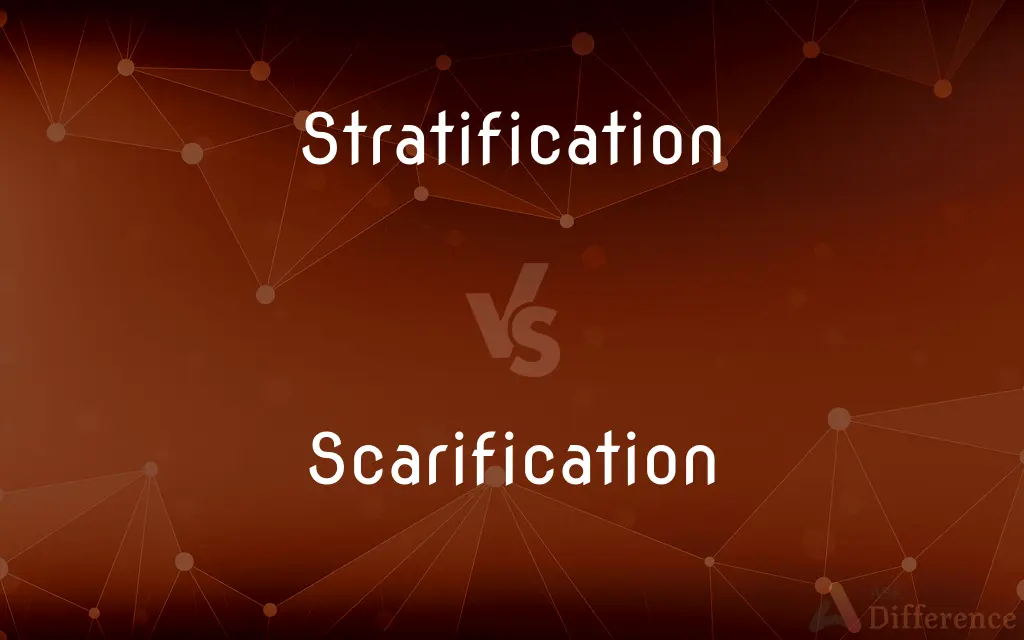Stratification vs. Scarification — What's the Difference?
By Maham Liaqat & Fiza Rafique — Updated on March 20, 2024
Stratification involves simulating natural conditions to break seed dormancy, while scarification physically or chemically alters seed coats to promote germination.

Difference Between Stratification and Scarification
Table of Contents
ADVERTISEMENT
Key Differences
Stratification is a method used to break the dormancy of seeds by exposing them to specific periods of cold or warm temperatures, mimicking the natural conditions they would experience in the wild. This process often involves mixing seeds with moist sand or peat and refrigerating them for several weeks or months. On the other hand, scarification involves weakening, breaking, or otherwise altering the seed coat to encourage water absorption and gas exchange, which are critical for germination. Methods include mechanical abrasion, chemical treatment with acids, or hot water soaking.
Scarification is typically necessary for seeds with especially hard, impermeable coats that prevent water from entering, such as those of legumes. It's a quicker process compared to stratification, which can take several months to effectively break seed dormancy. Whereas stratification simulates seasonal changes, scarification directly modifies the seed's physical barriers.
The need for stratification or scarification depends on the species of the plant and its natural habitat. Stratification is often required for seeds of temperate climates where winters naturally break dormancy, ensuring seeds germinate in favorable conditions. Scarification, however, is commonly needed for seeds from arid or semi-arid regions, where physical disturbances naturally occur to break down seed coats.
Both techniques enhance germination rates but serve different types of seeds based on their dormancy and coat characteristics. Stratification is a gentler, time-consuming method suitable for seeds sensitive to environmental cues. Scarification, in contrast, is more immediate and physical, tailored to seeds that are resistant to water and gas exchange due to their tough exterior.
While stratification can sometimes be substituted with other methods of dormancy breaking, such as chemical treatments that mimic cold periods, scarification remains a unique requirement for seeds with hard coats. There are no alternatives that replicate the physical or chemical weakening of the seed coat as effectively as scarification methods.
ADVERTISEMENT
Comparison Chart
Purpose
To break seed dormancy by simulating natural cold/warm periods
To weaken the seed coat to promote water absorption
Method
Cold or warm moist treatment
Physical or chemical alteration of the seed coat
Duration
Weeks to months
Immediate to several hours
Seed Type
Temperate climate seeds
Seeds with hard, impermeable coats
Mechanism
Mimics environmental seasonal changes
Directly modifies physical barriers
Necessity
For seeds requiring environmental cues
For seeds resistant to water and gas exchange
Alternatives
Chemical treatments
None as effective for hard-coated seeds
Application
Seeds sensitive to environmental changes
Seeds with tough exterior
Compare with Definitions
Stratification
A process of treating seeds to simulate natural environmental conditions to break dormancy.
Stratification of apple seeds involves chilling them for several weeks before planting.
Scarification
Aids in water absorption and gas exchange.
Scarification helps seeds absorb water more readily.
Stratification
Often used for seeds of plants from temperate regions.
Many temperate climate plants' seeds won't germinate without stratification.
Scarification
Can involve chemical treatments to weaken the seed coat.
Acid scarification speeds up germination in tough-coated seeds.
Stratification
Mimics winter or summer conditions to stimulate germination.
Stratification tricks seeds into thinking they've experienced winter.
Scarification
The act of breaking, scratching, or softening the seed coat to encourage germination.
Scarification can be done by gently rubbing seeds with sandpaper.
Stratification
Requires cold or warm moist conditions depending on the seed type.
Some perennial seeds need cold stratification to germinate in spring.
Scarification
Can be quickly done, unlike stratification.
Scarification of some seeds can be completed in minutes with hot water.
Stratification
Can be done using a refrigerator for cold stratification.
Home gardeners often use their fridge for seed stratification.
Scarification
Necessary for seeds with hard, water-impermeable coats.
Legume seeds often require scarification before planting.
Stratification
Formation or deposition of layers, as of rock or sediments.
Scarification
Scarifying (also scarification modification) involves scratching, etching, burning / branding, or superficially cutting designs, pictures, or words into the skin as a permanent body modification. The body modification can take roughly 6–12 months to heal.
Stratification
The condition of being stratified.
Scarification
To make shallow cuts in (the skin), as when vaccinating.
Stratification
A layered configuration.
Scarification
To create a design on (the skin) by means of shallow cuts that are sometimes rubbed with a colorant or irritant to enhance the resulting scar tissue.
Stratification
The process leading to the formation or deposition of layers, especially of sedimentary rocks
Scarification
To break up the surface of (topsoil or pavement).
Stratification
(music) a layering of musical texture
Scarification
To distress deeply, as with severe criticism; lacerate.
Stratification
(ecology) the vertical layering of vegetation in a forest
Scarification
(Botany) To slit or soften the outer coat of (seeds) in order to speed germination.
Stratification
(sociology) society's categorization of people into socioeconomic strata
Scarification
The act of scarifying: raking the ground harshly to remove weeds, etc.
Stratification
(horticulture) process of treating seeds to simulate natural conditions that the seeds must experience before germination can occur; most often the process involves exposure to cold in which case it may also be called cold treatment
Scarification
A medieval form of penance in which the skin was damaged with a knife or hot iron.
Stratification
The act or process of laying in strata, or the state of being laid in the form of strata, or layers.
Scarification
The scratching, etching, burning / branding, or superficially cutting designs, pictures, or words into the skin as a permanent body modification.
Stratification
The deposition of material in successive layers in the growth of a cell wall, thus giving rise to a stratified appearance.
Scarification
(medicine) A route of administration for some vaccinations and tests: rather than hypodermic injection, the site is inoculated intradermally not with any injection but rather only with small, shallow pricks or scratches; the needle is not hollow.
Stratification
The act or process or arranging persons into classes or social strata
Scarification
The act of scarifying.
Stratification
The condition of being arranged in social strata or classes within a group
Stratification
Forming or depositing in layers
Stratification
A layered configuration
Stratification
The placing of seeds in damp sand or sawdust or peat moss in ordere to preserve them or promote germination
Common Curiosities
What is seed scarification?
Seed scarification involves physically or chemically altering the seed coat to improve water absorption and facilitate germination.
How long does stratification take?
Stratification can take from a few weeks to several months, depending on the seed type and required conditions.
What is seed stratification?
Seed stratification is a process of simulating natural environmental conditions to break seed dormancy, often involving cold or warm moist treatments.
What is cold stratification?
Cold stratification is a method where seeds are mixed with moist material and stored in a cold environment to mimic winter conditions.
How do I know if a seed needs stratification or scarification?
This usually depends on the plant species and can often be found in gardening guides or on the seed packet instructions.
Can I skip stratification and still get germination?
Some seeds may germinate without stratification, but the rate and success of germination can significantly decrease.
Can scarification be done at home?
Yes, scarification can be easily done at home using mechanical means like sandpaper or chemical means such as acid or hot water.
Can all seeds be scarified?
Not all seeds need scarification, only those with hard, impermeable coats that inhibit water absorption.
How does stratification affect germination time?
Stratification can reduce germination time by breaking dormancy and making seeds ready to germinate as soon as they are planted in suitable conditions.
Why are stratification and scarification important for seed germination?
They improve germination rates by overcoming dormancy in stratification and promoting water and gas exchange in scarification.
What tools are needed for scarification?
Tools can range from simple sandpaper for mechanical abrasion to chemicals like sulfuric acid for chemical treatments.
Is stratification a natural process?
Yes, stratification mimics the natural process of seasonal changes that many seeds would undergo in their native habitats.
What are common methods of scarification?
Common methods include mechanical abrasion, chemical treatment, and soaking in hot water.
Are there seeds that require both stratification and scarification?
Yes, some seeds may benefit from both processes, especially if they have a hard coat and also require specific environmental cues for germination.
Why don't all seeds require stratification or scarification?
The need for these processes is based on the seed's natural dormancy mechanisms and coat characteristics
Share Your Discovery

Previous Comparison
Lichee vs. Lychee
Next Comparison
Ghagra vs. LehengaAuthor Spotlight
Written by
Maham LiaqatCo-written by
Fiza RafiqueFiza Rafique is a skilled content writer at AskDifference.com, where she meticulously refines and enhances written pieces. Drawing from her vast editorial expertise, Fiza ensures clarity, accuracy, and precision in every article. Passionate about language, she continually seeks to elevate the quality of content for readers worldwide.














































